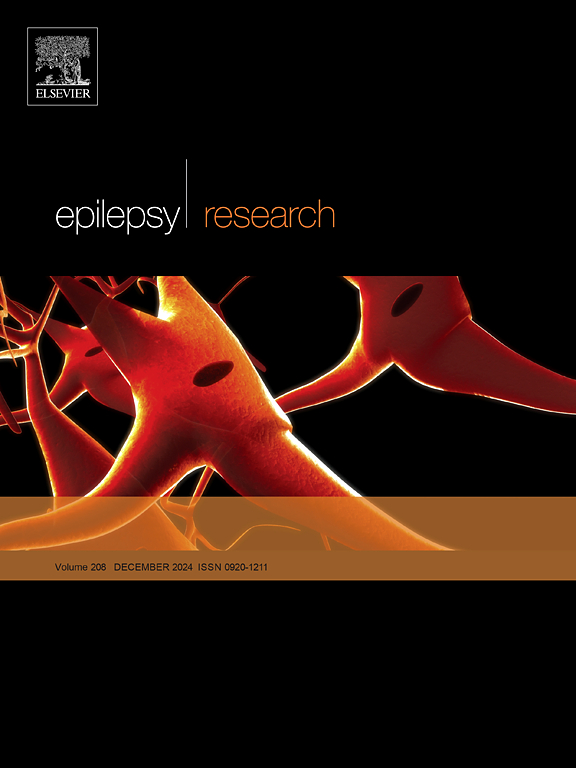Associating clinical outcomes and number of antiseizure medications in refractory status epilepticus
IF 2
4区 医学
Q3 CLINICAL NEUROLOGY
引用次数: 0
Abstract
Background/objective
Prior studies have not directly evaluated the association between number of antiseizure medications (ASMs) and neurological outcomes. The objective of this study was to evaluate the association between the number of ASMs administered to patients in refractory SE and modified Rankin Scale (mRS) score at discharge.
Methods
This was a retrospective cohort analysis of adults with SE from 2020 to 2023. Exclusion criteria included pregnancy, post-arrest myoclonus, and ≤ 2 non-benzodiazepine ASMs during admission. Patients were grouped by number of non-benzodiazepine ASMs received during admission (2, 3, or ≥4 ASMs). The primary outcome was mRS score at discharge.
Results
The study included 287 patients (2 ASMs: 86, 3 ASMs: 82, ≥4 ASMs: 119), predominantly white (52.6 %) non-Hispanic (92.0 %) males (57.8 %) aged 55 – 60 years. Most patients had a history of epilepsy (73.9 %) and presented with convulsive SE (66.9 %). Patients receiving ≥ 4 ASMs had a higher median mRS score (4 vs. 1 vs. 1, p = 0.0001) and higher level of care at discharge (p = 0.0001) than comparators. Hospital and intensive care unit lengths of stay were longer in the ≥ 4 ASM group (12.2 and 6.0 days, respectively) than in comparator groups (2 ASMs: 5.5 and 2.2 days; 3 ASMs: 5.8 and 2.8 days; p < 0.001).
Conclusions
The results of this study suggest that patients requiring ≥ 4 ASMs for treatment of SE have worse neurological outcomes. These results may inform treatment preferences for refractory SE and provide data for risk-benefit discussions.
难治性癫痫持续状态的相关临床结果和抗癫痫药物的数量
背景/目的先前的研究没有直接评估抗癫痫药物(asm)数量与神经系统预后之间的关系。本研究的目的是评估难治性SE患者接受asm治疗的次数与出院时改良Rankin量表(mRS)评分之间的关系。方法对2020 - 2023年成人SE患者进行回顾性队列分析。排除标准包括妊娠、骤停后肌阵挛、入院时≤ 2次非苯二氮卓类药物痉挛。根据入院期间接受非苯二氮卓类药物性高潮的次数(2次、3次或≥4次)对患者进行分组。主要观察指标为出院时mRS评分。结果共纳入287例患者(2个asm: 86例,3个asm: 82例,≥4个asm: 119例),年龄55 ~ 60岁,以白人(52.6% %)和非西班牙裔(92.0 %)男性(57.8% %)为主。大多数患者有癫痫史(73.9 %),并表现为惊厥性SE(66.9% %)。接受≥ 4次asm的患者比对照者有更高的中位mRS评分(4比1比1,p = 0.0001)和更高的出院护理水平(p = 0.0001)。≥ 4 ASM组住院时间和重症监护病房时间(分别为12.2和6.0天)均长于对照组(2 ASM: 5.5和2.2天;3 asm: 5.8天和2.8天;p & lt; 0.001)。结论本研究结果提示,需要≥ 4个asm治疗SE的患者神经系统预后较差。这些结果可能为难治性SE的治疗选择提供信息,并为风险-收益讨论提供数据。
本文章由计算机程序翻译,如有差异,请以英文原文为准。
求助全文
约1分钟内获得全文
求助全文
来源期刊

Epilepsy Research
医学-临床神经学
CiteScore
0.10
自引率
4.50%
发文量
143
审稿时长
62 days
期刊介绍:
Epilepsy Research provides for publication of high quality articles in both basic and clinical epilepsy research, with a special emphasis on translational research that ultimately relates to epilepsy as a human condition. The journal is intended to provide a forum for reporting the best and most rigorous epilepsy research from all disciplines ranging from biophysics and molecular biology to epidemiological and psychosocial research. As such the journal will publish original papers relevant to epilepsy from any scientific discipline and also studies of a multidisciplinary nature. Clinical and experimental research papers adopting fresh conceptual approaches to the study of epilepsy and its treatment are encouraged. The overriding criteria for publication are novelty, significant clinical or experimental relevance, and interest to a multidisciplinary audience in the broad arena of epilepsy. Review articles focused on any topic of epilepsy research will also be considered, but only if they present an exceptionally clear synthesis of current knowledge and future directions of a research area, based on a critical assessment of the available data or on hypotheses that are likely to stimulate more critical thinking and further advances in an area of epilepsy research.
 求助内容:
求助内容: 应助结果提醒方式:
应助结果提醒方式:


